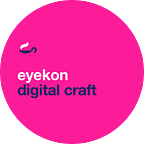Dear Native Apps: It’s Time to Scoot Over and Make Space for Progressive Web Apps.
Steve Jobs even said it back in 2007*. So, why build a website and a native app when the progressive web app can give you the best of both?
It is advertised as an innovative hybrid solution between website and app — but what exactly is a Progressive Web App (PWA)? How does it differ from a native App? Is it the next big thing?
You may have already come across the term “Progressive Web App” — because it’s becoming more and more common in the digital world. If you understood each of those words separately but have no idea of the whole picture, then we’re on the same page. But I (intern, largely unversed in technology and software development) couldn’t let that slide — after all, at our agency, Eyekon, we manufacture PWAs for our customers. That’s why I sat down with Jonas Fahrni (Eyekon’s technology expert, definitely understands how the Internet works) to learn more.
A basic question to start with: What is a PWA? How does a PWA differ from a website or a native app?
It is somewhere in the middle of the two — essentially a website that behaves like a native app. The user has the feeling of using a native app, but technically it is a website. It has touch elements and functions, instead of a classic navigation, and animation and auto-reloading of content. It contains most of what makes an app.
So neither fish nor fowl, you could say. What are the advantages of a progressive web application?
Intuitive user experience (Jonas takes out his smartphone and opens “AstroRara”, the PWA we developed for the ETH-Library). Look, it reacts to touch, so you can navigate just like in an app. PWAs are more intuitive than websites, but just as easy to access — unlike native apps, you don’t have to download and install them from the App Store first. All you need is a URL. Then add the PWA to your home screen so it appears under all your native apps. This also makes things easier for clients and developers:
The process of publication in various App-Stores, and the fees associated with it, are dropped. If something is changed or updated, it’s automatically live. The user does not need to continually install updates to keep up to date.
So my conclusion: They’re more accessible, faster and easier.
Sounds promising. But as a customer I would also be interested in the costs. Are PWAs cheaper than native apps?
Generally yes — because you don’t have a technically independent website plus an app, each of which have to be built separately. A native app normally cannot be used on a desktop, so you still need a website. It’s like in the movie ‘Contact’ (with Jodie Foster, 1997; in one scene the first (very expensive) space transporter is blown up, but then the terminally ill billionaire S. R. Hadden reveals that he had a second one built unnoticed, just in case).
Spending large sums of money “just in case” is not necessarily something we recommend. In addition, companies that run both a website and native apps must pay for the maintenance of both.
So there is a lot to be said for a PWA. But how does it play out in reality? Do customers come to you and ask for a PWA?
No, unfortunately PWAs are still not really on the radar for a lot of clients. Especially in marketing, a native app is still considered the ultimate — the best way to reach target groups via mobile devices. The thing is, a PWA also offers advantages here: It’s discoverable, and you can do organic SEO with content on the PWA itself, and it has better capabilities to track various metrics. It can advertise itself. To market a native app, on the other hand, you basically have to create an advertisement, which leads to a website that then redirects to the App Store. A bit cumbersome, isn’t it?
This all sounds almost too good to be true — I’m a bit skeptical. Surely there are disadvantages?
From a technological point of view, there are few things a PWA cannot do, such as access contact lists or Bluetooth. To access really sensitive data on a smartphone, a native app is usually required. However, many sensors such as location determination and accelerometers can also be read with a PWA.
The far bigger problem is false expectations. A user expects an app to be started from the home screen. But a PWA requires a first step: you access it first in the browser and then can save to the homescreen. Android comes in handy here, and automatically points to this option when visiting a PWA website. iOS, on the other hand, is less cooperative.
It’s ironic actually, since back in 2007 Steve Jobs talks about developing ‘mobile web apps’ (today’s PWA) rather than native apps (*watch the address here), but these days Apple is one of the biggest ‘blocks’ to PWAs.
As a result, we are still mostly used to using native apps. It’s more straightforward for a company to be able to say to its customers, “go to the App Store and download our app”.
Could the status of PWAs change in the future?
I believe that the boundaries between PWAs and websites will merge — we are already seeing more and more websites appearing that take advantage of the features of native apps. As web development continues, PWAs will also evolve, and with them, usage habits and expectations. The challenge is simply to communicate the benefits. At Eyekon we will definitely continue to recommend PWAs to our customers.
Would you like to develop a PWA for your business or project? Or just discuss the merits of PWAs versus native apps? Jonas and the team would be glad to hear from you.
Interview conducted by Sydney Luca-Lion with Jonas Fahrni
